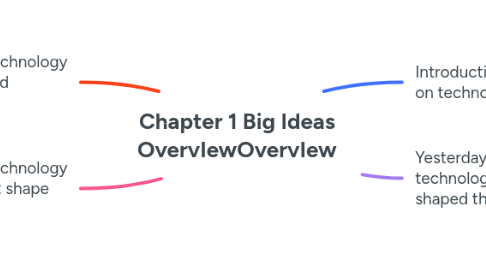
1. Today’s educational technology resources: systems and applications
1.1. An Overview of Digital Technology Tools
1.1.1. Technology integration strategies require a combination of hardware, or computing equipment, and software, or programs written to perform various functions. Even today’s mobile devices, or portable, handheld computer equipment, such as cell phones or tablets, have this hardware/software combination.
1.2. Technology Facilities: Hardware and Configurations for Teaching
1.2.1. Microcomputers
1.2.2. - Handheld technologies
1.2.3. - Display technologie
1.2.4. - Imaging technologie
1.2.5. - Peripherals
1.2.6. - External storage
1.2.7. - Laboratories of networked computers.
1.3. Types of Software applications in School
1.3.1. Instructional
1.3.2. Productivity—Programs
1.3.3. Administrative
2. Today’s educational technology issues: conditions that shape practice
2.1. Social issues
2.1.1. School systems have recognized that social issues impact every school’s mission and classroom climate and must be addressed by sound policies and a planned, ongoing education program to make teachers and students aware of these concerns and to limit possible negative impact.
2.2. Privacy issues.
2.2.1. - Health- related concern
2.2.2. Fears about technology misuses
2.2.3. Risks of online behaviors.
2.2.4. Malware, viruses, spam, and hacking
2.3. Educational Issues
2.3.1. Several kinds of educational issues have special implications for the ways technology is used in teaching and learning - Lack of technology funding. - Teacher and student accountability for quality and progress. - Digital literacy and digital citizenship. - Debates on best practices with technologies. - Reliance on online learning.
2.4. Cultural and Equity issue
2.4.1. The power of technology is a double- edged sword, especially for education. While it presents obvious potential for changing education and empowering teachers and students, technology may also further divide members of our society along socioeconomic, ethnic, and cultural lines and widen the gender gap.
3. Introduction: The “BIG PICTURE” on technology in education
3.1. Why We Need the “Big Picture
3.1.1. big picture
3.1.1.1. section serves an important purpose: It helps new learners develop mental pictures of the field, what Ausubel (1968)
3.1.2. Key terminology.
3.1.2.1. Talking about a topic requires knowing the vocabulary relevant to that topic.
3.1.3. Reflecting on the past
3.1.3.1. Showing where the field began helps us understand where it is headed and why
3.1.4. Considering the present
3.1.4.1. two factors: available technology resources and our perspectives on how to use them. Available technologies dictate what is possible; a combination of social, instructional, cultural, and legal issues influence the directions we choose to take.
3.1.5. Looking ahead to the future.
3.1.5.1. . Technology resources and societal conditions change so rapidly that today’s choices are always influenced as much by emerging trends as by current conditions.
3.2. Perspectives That Define Educational Technology
3.2.1. Instructional Technology
3.2.1.1. defined educational technology as both “the media born of the communication revolution which can be used for instructional purposes”
3.2.2. Perspective #1: Educational technology as communications media.
3.2.3. Perspective #2: Educational technology as instructional systems and instructional design.
3.2.4. Perspective #3: Educational technology as vocational training.
3.2.5. Perspective #4: Educational technology as computer systems (a.k.a., educational and instructional computing).
3.3. How This Textbook Defines Technology in Education
3.3.1. Processes learning
3.3.1.1. theories based on the sciences of human behavior, and (2) applications of technology that help prepare students for future jobs by teaching them skills in using current tools, as well as skills in “learning to learn” about tools of the future that have not yet been invented—or even imagined
3.3.2. Tools
3.3.2.1. This textbook looks at the roles technology tools play as delivery media, instructional systems, and technology support, and focuses primarily on those tools that play a current, high- p rofile role in furthering teaching and learning.
3.3.3. Educational technology
3.3.3.1. is a combination of the processes and tools involved in addressing educational needs and problems, with an emphasis on applying the most current digital and information tools
3.3.4. Integrating educational technology
3.3.4.1. refers to the process of matching digital tools and methods to given educational needs and problems.
3.3.5. Instructional technology
3.3.5.1. is the subset of educational technology that deals directly with teaching and learning applications (rather than educational administrative ones).
4. Yesterday’s educational technology: How the past has shaped the present
4.1. Era 1: The Pre- Microcomputer Era
4.1.1. The first computers were used instructionally as early as the 1950s
4.2. Era 2: The Microcomputer Era
4.2.1. Integrated circuits made computers both smaller and more portable beginning in 1975, and teachers began to bring small, s tand- alone, desktop computers called microcomputer
4.3. Era 3: The internet Era
4.3.1. At the beginning of the 1990s, the Internet, a worldwide collection of university computer networks that could exchange information by using a common software standard had already been operating for many years.
4.4. Era 4: The Mobile Technologies, Social Media, and Open access Era
4.4.1. The current era began the early 2000s, when portable devices such as smartphones and tablets made Internet access and computer power ubiquitous
4.5. What We Have learned from the Past
4.5.1. - No technology is a panacea for education. - Teachers usually do not develop technology materials or curriculum. - “Technically possible” does not equal “desirable, feasible, or i nevitable.” - Technologies change faster than teachers can keep up. - Older technologies can be useful.
